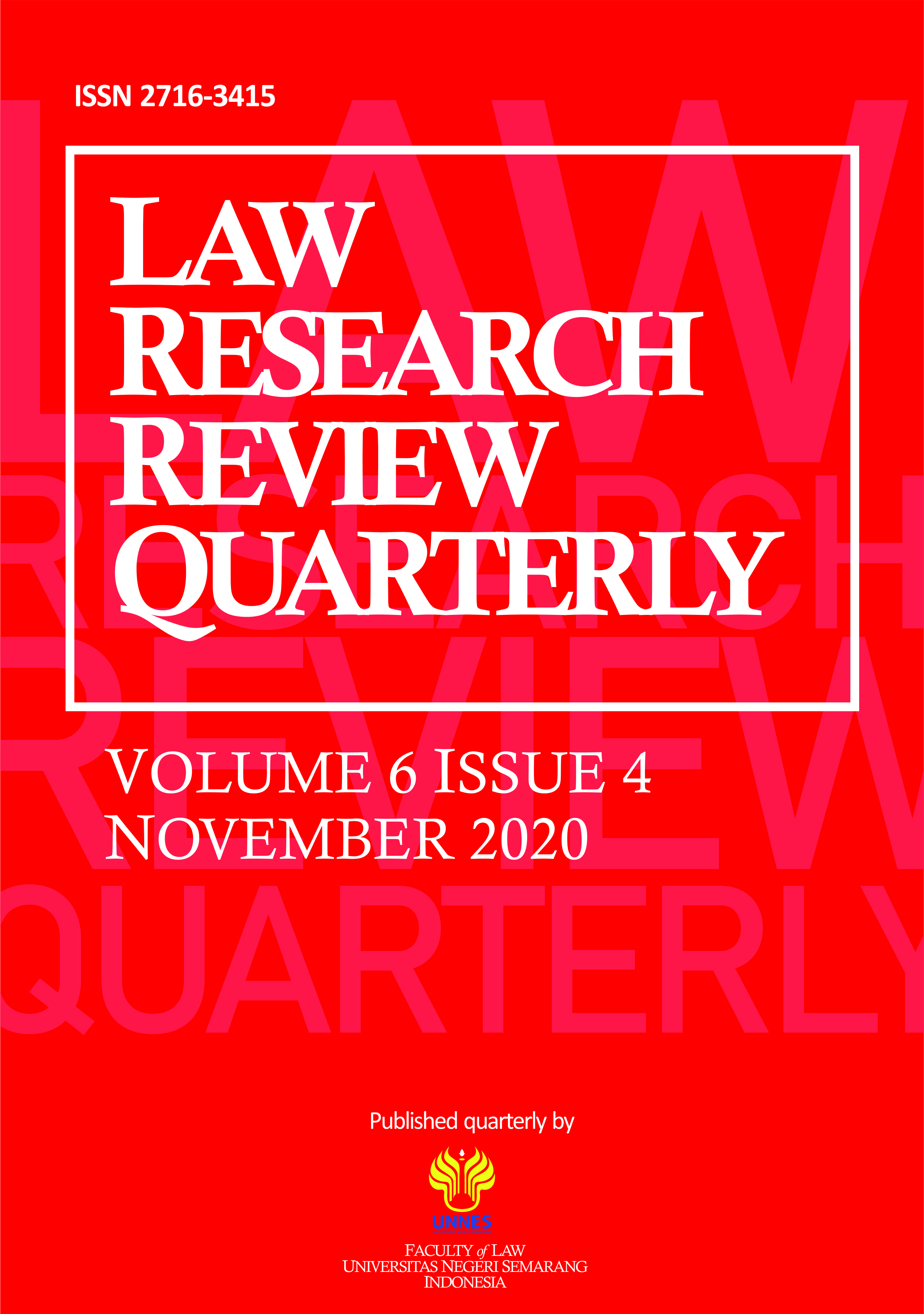Juvenile Delinquency and Theft: How Law and Criminology Said?
Main Article Content
Abstract
The phenomenon of child delinquency is closely related to child crime and according to many experts this is motivated by socially unacceptable behavior such as excessive acts at school, offenses such as running away from home to criminal behavior. Child delinquency is not only criminal acts, but all acts committed by children that are deemed to violate social, school or community values. Children aged 12 to 18 years (Law No. 12 of 2012, is an age range which in a psychological perspective is classified as adolescence which has developmental characteristics that may make it difficult for children to adapt, causing behavioral problems. In many cases of crimes involving children, various theories of criminology and law try to analyze them, starting from the psychological, environmental, and other external factors. This research aims to analyze the crime of theft by coercion (begal) committed by children through an analytical approach to criminological theory and law. This research showed that internal and external factors influence the level of crimes committed by children. In addition, this research has revealed that the Delinquent Subculture and the Differential Association answer why children commit crimes, starting from imitation and environmental factors, including family and school environment.
Article Details
All writings published in this journal are personal views of the authors and do not represent the views of this journal and the author's affiliated institutions. Author(s) are retain the copyrights of the Article. However, before publishing, it is required to obtain written confirmation from Author(s) in order to ensure the originality (Author Statement of Originality). The statement is to be signed by at least one of the authors who have obtained the assent of the co-author(s) where applicable.This work licensed under a Creative Commons Attribution-ShareAlike 4.0 International (CC BY-SA 4.0)
References
Ardi, Z., & Sisin, M. (2018). The Contribution of Assertive Technique Behavioral Counseling to Minimize the Juvenile Delinquency Behavior. Jurnal Konseling dan Pendidikan, 6(2), 67-77.
Atmasasmita, R. (1983). Problem Kenakalan Anak-Anak Remaja. Bandung: Armico.
Chusniyah, T. (2014). “Penyebab Kenakalan dan Kriminalitas Anakâ€, Online, retrieved from http://fppsi.um.ac.id/?p=1276
Djanggih, H., & Qamar, N. (2018). Penerapan Teori-Teori Kriminologi dalam Penanggulangan Kejahatan Siber (Cyber Crime). Pandecta Research Law Journal, 13(1), 10-23.
Guntur, W. S. (2019). Kajian Kriminologi Pelaku Pembegalan. Diversi: Jurnal Hukum Pidana dan Penanggulangan Kejahatan, 8(2), 117-124.
Hagan, F. E. (2014). Pengantar Kriminologi: Teori, Metode, dan Perilaku Kriminal. Jakarta: Prenada Media Group.
Haq, N. B. (2018). Peran Humas Polres Lumajang dalam Meminimalisir Tindak Pidana Begal di Kabupaten Lumajang. Doctoral Dissertation, Universitas Muhammadiyah Jember.
Husada, A. A. (2018). Analisis Kriminologis Terhadap Kejahatan Begal di Wilayah Hukum Kabupaten Malang. Journal Institutional Repository, 4(4), 225-236.
Imballoo, I. (2017). Optimalisasi Patroli Roda Empat Satuan Sabhara dalam Mencegah Tindak Pidana Pencurian Kendaraan Bermotor di Wilayah Hukum Polres Kudus. Police Studies Review, 1(1), 381-430.
Indrijati, H. (2017). Juvenile delinquency of senior high school students in Surabaya, Indonesia. International Journal of Psychological and Behavioral Sciences, 11(1), 184-188.
Januati, F., & Miharja, M. (2019). Fenomena Kriminalitas Remaja di Kota Depok. Pakuan Law Review, 5(2), 234-245.
Jufri, M., Nazeri, N. M., & Dhanapal, S. (2019). Restorative Justice: An Alternative Process for Solving Juvenile Crimes in Indonesia. Brawijaya Law Journal: Journal of Legal Studies, 6(2), 157-169.
Juliana, R., & Arifin, R. (2019). Anak dan Kejahatan (Faktor Penyebab dan Perlindungan Hukum). Jurnal Selat, 6(2), 225-324.
Effendi, Tolib. Dasar-Dasar Kriminologi. Jakarta: Publisher Setara Press, 2017.
Kartono, K. (2014). Patologi Sosial 2 Kenakalan Remaja. Jakarta: Rajawali Pers.
Latifiani, D., & Arifin, R. (2018). Katakan Tidak Pada Main Hakim Sendiri. Penjelasan, Penangulangan, dan Penanganan: Buku Saku Pencegahan Eigenrichting. Semarang: BPFH UNNES.
Lily, J. R. (2015). Teori Kriminologi Konteks dan Konsekuensi. Jakarta: Kencana.
Noer, K. U. (2019). Mencegah Tindak Kekerasan pada Anak di Lembaga Pendidikan. Sawwa: Jurnal Studi Gender, 14(1), 47-66.
Putra, R. T. (2017). Peran Bhabinkamtibmas Polsek Margorejo Dalam Mencegah Tindak Pidana Curanmor Di Wilayah Hukum Polres Pati. Advances in Police Science Research Journal, 1(2), 423-470.
Putri, G. A. M. (2018). Kejahatan Begal yang Dilakukan oleh Anak di Kabupaten Tanggamus (Perspektif Kriminologi). Doctoral Dissertation, Universitas Lampung.
Ramadhan, R. (2017). Penyelenggaraan Kota Layak Anak di Kota Depok (Studi Penelitian di Kota Depok Tahun 2015). Journal of Politic and Government Studies, 6(2), 1-10.
Utari, I. S. (2012). Aliran dan Teori Dalam Kriminologi. Yogyakarta: Thafa Media.
Ren, L., Zhang, H., Zhao, J. S., & Zhao, R. (2016). Delinquent subculture and juvenile offenders’ attitudes toward the police in China. Police Quarterly, 19(1), 87-110.
Rifai, I. (2016). The Emergence of Youth Violence in Indonesia: A Socio-Historical Analysis. Islam Realitas: Journal of Islamic and Social Studies, 2(1), 105-117.
Sari, F. A. (2019). Knowledge, Attitude, and Behavior of Depok Residents regarding Child Sexual Abuse. Jurnal Forensik dan Medikolegal Indonesia, 1(1), 11-17.
Santrock, J. W. (2003). Psychology: Essentials. Boston: McGraw-Hill.
Setyawan, D. P. (2017). Pengaruh Pengawasan Terhadap Kinerja Anggota Satuan Lalu Lintas Polres Sukoharjo. Advances in Police Science Research Journal, 1(4), 1261-1314.
Sianipar, C. M. (2020). The Role of Bhabinkamtibmas Through Door to Door System in Preventing Motor Vehicle Theft. Tanggon Kosala, 9(1), 19-38.
Suwitno, S. (2018). Legal Protection of Vehicle Users by Under Age (Minors) Viewed from The Perspective at Present Act No. 22 of 2009 on Traffic and Transportation. Jurnal Daulat Hukum, 1(2), 501-508.
Sutherland, E. H., Cressey, D. R., & Luckenbill, D. F. (1992). Principles of criminology. Lanham, Maryland US: Altamira Press.
Umam, M.M., & Arifin, R. (2019). Aksesabilitas Kaum Difabel dalam Perlindungan Hukumnya dalam Perspektif Hak Asasi Manusia. Pena Justisia: Media Komunikasi dan Kajian Hukum, 18(1), 46-54. http://dx.doi.org/10.31941/pj.v18i1.1089
Utari, I. S., Sumardiana, B., Sastroadmodjo, S., & Ramada, D. P. (2019, August). Social Controls and Trends Juvenile Delinquency: Criminology Study about Complexity Of Child Delinquency In Society. In 1st International Conference on Education Social Sciences and Humanities (ICESSHum 2019) (pp. 858-863). Atlantis Press.
